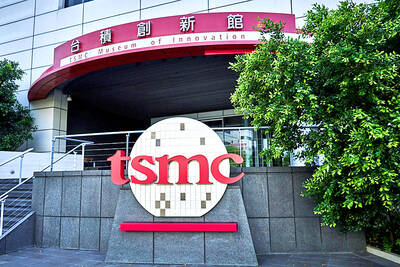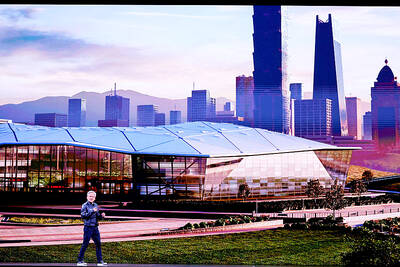Apple Inc is expected to crank out a small volume of next-generation Micro-LED displays from a plant in Taoyuan by the end of this year for its wearable devices, an IDC analyst said yesterday.
The US technology giant is forecast to begin mass production of Micro-LED displays at the plant in Longtan District (龍潭) next year, ahead of rival display makers, IDC analyst Annabelle Hsu (徐美雯) said.
Apple might initially use the brighter, more energy efficient and foldable Micro-LED displays on new Apple Watches, Hsu said.
The company has kept a low profile about the Longtan display factory since it began operations two years ago. The Hsinchu Science Park Bureau in 2015 confirmed the presence of the Apple plant, without elaborating.
Apple has placed more focus on Micro-LED technology after acquiring LuxVue Technology Corp in 2014.
The newest self-emitting display technology shares traits with expensive organic LED (OLED) technology, but costs less.
“Many display makers consider Micro-LED technology a panacea for making flexible displays due to lower technological barriers, compared with OLED technology,” Hsu said. “Flexible display technologies are seen as the possible driving force to developments in end products in the next decade.”
However, Hsu does not expect Micro-LED technology to become commercially available before 2020.
Innolux Corp (群創), a Hon Hai Group (鴻海集團) flat-panel manufacturing subsidiary, has allocated resources to explore Micro-LED technology, but has not yet released any details.
Samsung Electronics Co is the only company in the world capable of supplying OLED panels for mobile phones at present, while LG Display Inc and AU Optronics Corp (友達光電) are mostly making smaller-sized OLED displays used in wearable devices, Hsu said.
APPLE PAY CONCERNS
In other news, the launch on Wednesday of Apple Pay in Taiwan has raised concerns about the possibility of declining credit card fee income for local banks, the Chinese-language Economic Daily News reported yesterday, citing an industry insider.
The newspaper said Apple would soon be joining issuing banks and network operators such as Visa Inc and MasterCard Inc in taking a slice of the profits from transaction fees.
“Apple Pay operates in existing transaction markets wherever credit cards are accepted; it is not a new segment and it does not make the pie bigger for issuer banks,” the newspaper quoted a bank manager, who wished to remain unidentified, as saying.
Apple Pay is not expected to catalyze significant growth in the local market for credit card transactions, but the new service would take its 0.0015 percent cut of transactions made with the mobile wallet, the manager said.
Compared with conventional credit cards, banks collect lower fees when purchases are made with Apple Pay, and fee income would decline more rapidly if the mobile wallet gains popularity, the manager said.
Market observers have said that the payment service, which is only available for Apple’s newer smartphones, trails behind that of the rival Android operating system.
Samsung, an Android smartphone maker, commands 24.6 percent of Taiwan’s smartphone market, compared with Apple’s 18.7 percent, market statistics showed.
Cathay United Bank (國泰世華銀行), the nation’s leading credit card issuer with 4.2 million active cards as of the end of last month and NT$392.9 billion (US$12.96 billion) total transactions last year, reported that credit card had contributed NT$5.7 billion out of the NT$18.4 billion in overall fee income that the bank earned last year.

SEEKING CLARITY: Washington should not adopt measures that create uncertainties for ‘existing semiconductor investments,’ TSMC said referring to its US$165 billion in the US Taiwan Semiconductor Manufacturing Co (TSMC, 台積電) told the US that any future tariffs on Taiwanese semiconductors could reduce demand for chips and derail its pledge to increase its investment in Arizona. “New import restrictions could jeopardize current US leadership in the competitive technology industry and create uncertainties for many committed semiconductor capital projects in the US, including TSMC Arizona’s significant investment plan in Phoenix,” the chipmaker wrote in a letter to the US Department of Commerce. TSMC issued the warning in response to a solicitation for comments by the department on a possible tariff on semiconductor imports by US President Donald Trump’s

The government has launched a three-pronged strategy to attract local and international talent, aiming to position Taiwan as a new global hub following Nvidia Corp’s announcement that it has chosen Taipei as the site of its Taiwan headquarters. Nvidia cofounder and CEO Jensen Huang (黃仁勳) on Monday last week announced during his keynote speech at the Computex trade show in Taipei that the Nvidia Constellation, the company’s planned Taiwan headquarters, would be located in the Beitou-Shilin Technology Park (北投士林科技園區) in Taipei. Huang’s decision to establish a base in Taiwan is “primarily due to Taiwan’s talent pool and its strength in the semiconductor

An earnings report from semiconductor giant and artificial intelligence (AI) bellwether Nvidia Corp takes center stage for Wall Street this week, as stocks hit a speed bump of worries over US federal deficits driving up Treasury yields. US equities pulled back last week after a torrid rally, as investors turned their attention to tax and spending legislation poised to swell the US government’s US$36 trillion in debt. Long-dated US Treasury yields rose amid the fiscal worries, with the 30-year yield topping 5 percent and hitting its highest level since late 2023. Stocks were dealt another blow on Friday when US President Donald

UNCERTAINTY: Investors remain worried that trade negotiations with Washington could go poorly, given Trump’s inconsistency on tariffs in his second term, experts said The consumer confidence index this month fell for a ninth consecutive month to its lowest level in 13 months, as global trade uncertainties and tariff risks cloud Taiwan’s economic outlook, a survey released yesterday by National Central University found. The biggest decline came from the timing for stock investments, which plunged 11.82 points to 26.82, underscoring bleak investor confidence, it said. “Although the TAIEX reclaimed the 21,000-point mark after the US and China agreed to bury the hatchet for 90 days, investors remain worried that the situation would turn sour later,” said Dachrahn Wu (吳大任), director of the university’s Research Center for